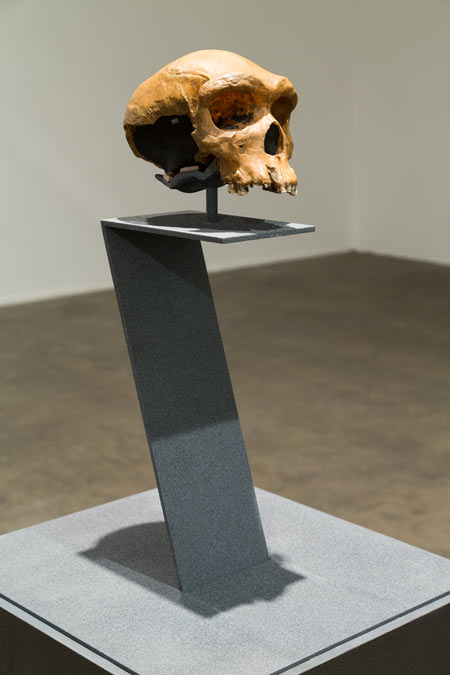William Kherbek reviews the Thai artist’s first UK solo show, which uses a replica of a replica to question our colonial legacy through a Möbius loop of artifice

One thing you can say for the middle ages, in those days, if you went out to find something, like say, the True Cross, you always managed to find it. Those were the days. Even when two different people were sent out in search of the same thing, say John the Baptist’s skull, for example, they both found it. Just try finding that kind of efficiency these days. It’s difficult, but it turns out, it’s not impossible. Perhaps in tribute to the recent reversion to medieval mentalities among the political classes of Europe, there’s a distinctly pre-modern feel to Pratchaya Phinthong’s exhibition Broken Hill at the Chisenhale Gallery. Pre-modern? Pre-historic is probably a more appropriate term, thinking about it. The show consists of a single work, a replica skull of the so-called “Broken Hill Man”, a transitional hominid species from the Lusaka National Museum on display next to a replica of the box in which the real skull is housed in its life at the British National History Museum.
The original skull was found in what is now Kabwe in Zambia. It was Northern Rhodesia at the time, hence the name homo rhodesiensis, named for that sterling exemplar of (in)humanity, Cecil Rhodes himself. In another development that will shock no one, the skull was taken from Africa, in violation of protocols put in place by the British South Africa Company itself, and magically transported to South Kensington where it resides unto the present. Zambia, as you might imagine, has asked if it can have its skull back, but curiously the Natural History Museum, perhaps attempting to set a new standard for the term “chutzpah” has suggested that the skull might not be entirely secure in Zambia. How do I know all this? Well, Kamfwa Chishala told me. Who’s he? He’s a museum guide from the Lusaka National Museum who accompanies the replica skull in its temporary home at the Chisenhale. He’s not to be trifled with, I kind of walked past him when I went in and he sprang out of his chair and began telling me the story with impressive brio. Phinthong fancies that Chishala’s role in the exhibition is “opening the work up to personal subjectivity”, and no doubt it’s true, but the sheer professionalism of Chishala makes the experience seem downright Victorian in its serious-mindedness and attention to detail.
There’s a moment of Troy McClure-ness when it all begins, and I do feel a little weird about an artist appropriating an African as part of an art work – I expect Phinthong wants me to feel that way – but soon, you can’t help but get taken in. It’s a powerful journey, especially if you go at a time when you can have a one on one interaction with Mr. Chishala. Curious, isn’t it, a man named Chishala at the Chisenhale gallery? But as the story of Broken Hill Man demonstrates, the truth almost always too weird to be true.
Broken Hill runs until 1 September at Chisenhale Gallery, 64 Chisenhale Road, London E3 5QZ




